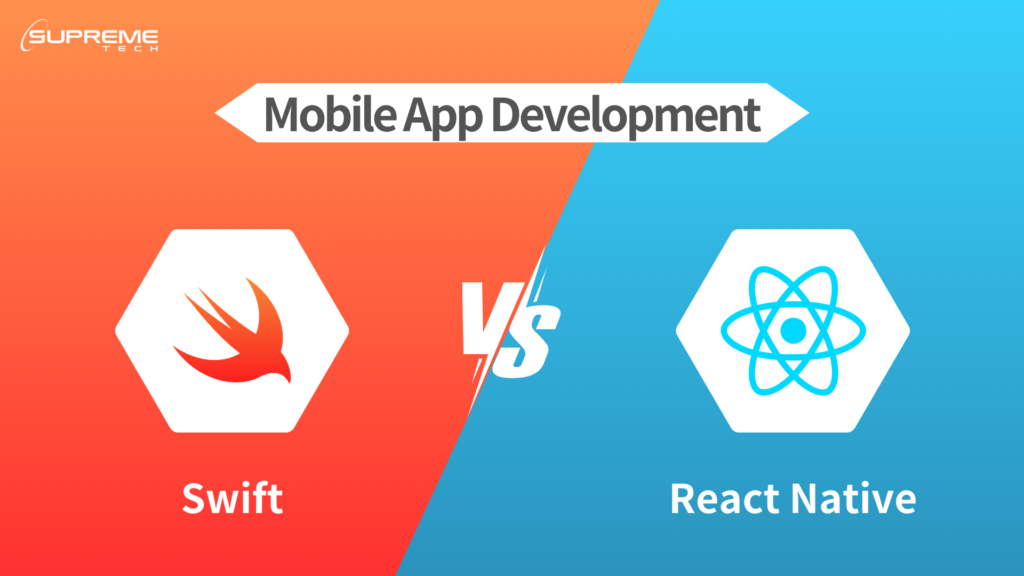Swift vs React Native for Mobile App Development in 2024
20/03/2024
728
Table of Contents
Hi tech fellows, welcome back to SupremeTech blog. It’s been a long holiday for us here in Viet Nam. But we are back, so here we go. When it comes to mobile app development, what language comes to your mind immediately? I believe two giants stand tall: Swift and React Native. But which one should you choose? Let’s break it down without the tech jargon.

Swift vs React Native: The origins
Swift, born from the Apple family, speaks the language of iOS like a native. It’s fast, it’s sleek, and it’s all about that iOS love. It boasts of native performance, modern syntax, and seamless integration with Apple’s ecosystem.
But React Native? It’s the rebel with a cause, using JavaScript to bring harmony between iOS and Android. It bridges the gap between iOS and Android, offering flexibility and efficiency in development.
Performance: Native vs Cross-platform
When it comes to speed, Swift takes the cake. It’s like a racing car, zooming ahead with native performance. Swift enjoys the advantage of native performance, thanks to its direct compilation to machine code. This results in snappy, responsive apps that align closely with iOS standards. React Native, while not inherently native, has made significant strides in optimizing performance. Techniques like Just-In-Time (JIT) compilation and native code modules contribute to smoother user experiences, albeit with a slight compromise compared to Swift in certain scenarios.
Development Time and Efficiency
Regarding development time, React Native emerges as the frontrunner. Its cross-platform nature allows developers to write code once and deploy it across multiple platforms, significantly reducing time and effort.
Swift, however, requires separate codebases for iOS and Android, potentially elongating development cycles. Nevertheless, Swift’s native approach ensures precise customization and adherence to platform-specific guidelines, which might justify the additional time investment for certain projects.
Community Support and Ecosystem
Both Swift and React Native thrive on vibrant communities and extensive ecosystems. Swift developers benefit from Apple’s backing and a growing community dedicated to enhancing the language and its ecosystem.
React Native, on the other hand, taps into the vast JavaScript community, offering a plethora of libraries, tools, and resources. This robust support system fosters innovation, facilitates problem-solving, and accelerates the development process for both frameworks.
UI/UX Design: Native Feel vs Cross-platform Consistency
Swift shines in delivering native user experiences tailored to iOS devices. With access to native UI components and seamless integration with Apple’s design principles, Swift apps exude elegance and sophistication. React Native, while capable of achieving native-like UI/UX, may exhibit slight discrepancies across platforms due to its bridge-based rendering approach. However, with careful design considerations and customization, React Native apps can deliver cohesive and visually appealing experiences on both iOS and Android.
Swift vs React Native: Maintenance and Future-proofing
Maintaining and updating mobile apps is an ongoing endeavor, and the choice of framework can significantly impact this process. Swift’s separate codebases for iOS and Android necessitate individual maintenance efforts, potentially increasing complexity and resource allocation. React Native’s single codebase streamlines maintenance tasks, allowing updates to be applied universally across platforms. This unified approach enhances agility, facilitates feature parity, and future-proofs applications against evolving technological landscapes.
Integration with Native Code and Third-party Libraries
Both Swift and React Native offer avenues for integrating native code and leveraging third-party libraries. Swift seamlessly interoperates with Objective-C, enabling access to a vast ecosystem of iOS libraries and frameworks. React Native provides a bridge that allows developers to incorporate platform-specific functionalities using Objective-C, Java, or Swift. This flexibility empowers developers to harness the strengths of both frameworks while capitalizing on existing libraries and resources.
So, is it Swift or React Native?
Despite their differences, Swift and React Native share some similarities in terms of criteria mentioned above. Ultimately, there is no one-size-fits-all solution. Whether you opt for Swift or React Native, both frameworks offer distinct advantages and cater to diverse needs within the mobile app development landscape. By weighing the factors discussed herein and aligning them with your project objectives, you can embark on a journey that leads to the realization of impactful, innovative mobile experiences.
Need a consultant for your development project? SupremeTech is here to help! When it comes to mobile app development, you are in our good hand. Dive in our success case studies to learn more about us.
See you in the next article!
Related Blog





















